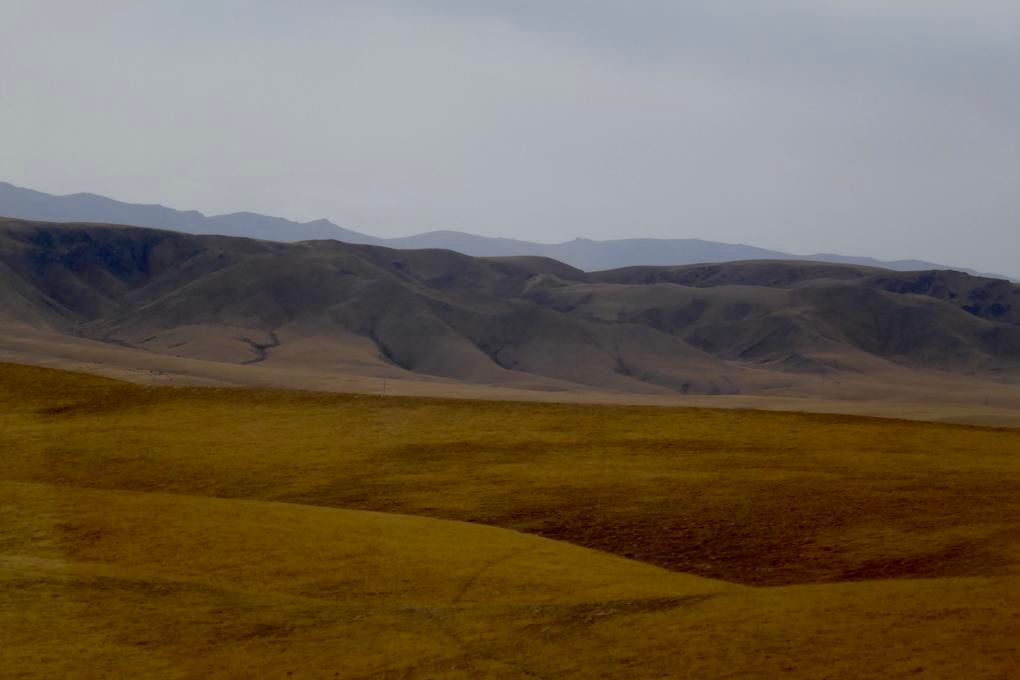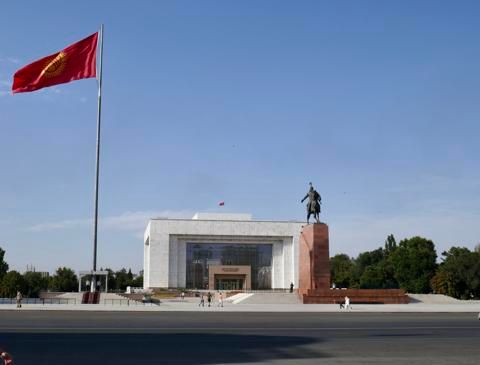Central Asia - Kyrgyzstan

Unlike Kazakhstan, Kyrgyzstan has few natural resources and as a consequence the country is not as wealthy and has little international investment. What it does have are fabulous mountain ranges and glaciers. In time they hope to build tourism around hiking, water rafting and areas where the pristine nature can be enjoyed.
The countryside is stark. At the border the queue was long with one lane closed. Frustrated drivers pushed their way in front of our coach – not the best outcome for two vehicles - very entertaining for us as tempers flared.


We spent a short time in the capital, Bishkek, another city flanked by fabulous mountains. We stopped at two large central squares surrounded by impressive government buildings and parkland.
The country’s flag dominates Ala-Too Square, (formally Lenin Square) with the Parliament building close by - known as the White House due to its colour and a tongue in cheek reference to the White House in Washington.
The square is so big, it is hard to photograph - on one side of the 6 lane road, gardens and impressive buildings (photo below left); on the otherside the State History Museum, national flag, the eternal flame and guard post (photo below centre); closeup of the Guard post(photo below right).



We arrived just at the right time to see the changing of the guard - serious young men marching with legs raised as high as possible with each step (Photo below left).
A statue of Lenin, which used to take pride of place in the centre of Ala-Too Square, is now relegated to the back of the History Museum (Photo below centre), while close by Marx and Engels look like they are enjoying a pleasant chat (Photo below right).



Further along a huge banner (photo below) featured General Usubaliev, Secretary General for 30 years and worked hard to navigate the country through the turbulent post-war period. As we stood there a local lady lingered - she told us proudly she’d worked for General Usubaliev.

In Victory Square an immense yurt shaped memorial (photo at the start of this post) was erected to recognise the 40th anniversary of the end of WWII, which in Central Asia is known as the Great Patriotic War.
We visited the State History Museum. Other than very recent times the history of Kazakhstan and Kyrgyzstan are very similar and the exhibits chronicle archaeological periods, the initial inhabitants, which were nomadic right through to Soviet times and for Kyrgyzstan, a little about the 6 presidents in charge since independence. I especially liked the section with Kyrgyz carpets and woven artefacts as well as the full size yurt.

A highlight in the evening was a private concert in an opulent restaurant by 4 musicians, dressed in traditional costumes, playing traditional Shashmaqam instruments - the music was captivating and I could just imagine reclining in a yurt listening to the haunting tunes.
The jaw harp I found the most intriguing - a tiny instrument reminding me of a complicated paper clip played between the lips.



I recorded a few snippets of the music - the video below is only around 1.5 minutes.
Along the way we passed some street scenes. Below a group of men relaxing in the back of their vehicle, two wearing kalpaks - the traditional hat worn by men in both Kazakhstan and Kyrgyzstan.

Kyrgyzstan has no remaining ancient towns or buildings of architectural significance as Timur, the epitome of tyrants (we’ll hear a lot more about him later in the tour), destroyed them all in 14th century and the towns were abandoned.
The Islamic religion spread through Central Asia in the 8th century. Old cities developed and emerged as new towns, and the centres of large cities improved.
We headed into the countryside and visited the remains of one such settlement was Balasagun located in what was ancient Burana. Minarets are evident in medieval cities of the East, usually built around mosques to call the faithful to prayer and often doubled as watch towers.
The first minarets date back to the 10th century and built of adobe bricks. The settlement of Burana was researched in pre-revolutionary times with conservation and restoration of the Burana Tower finally carried out in the 1970s.

The Burana tower is one of the first known minarets in Central Asia, dating back to 11th century - built around a mosque, the remains of which have not survived. The original height was 46m, but now is just 24m.
The area is also dotted with tools made of stones, tombstones with Arabic inscriptions, stone statues and petroglyphs.
Our day driving to Burana gave us an opportunity to take in some of the local everyday sights. Families picnicking, goats on the road, ramshackle houses and cars, the odd aircraft on display, reminding us of less peaceful times.
We came across 3 boys eager to hire out their horses - however they were just as happy with the chocolates and snacks we offered them, trying out their limited English.





It was an excellent road back to Bishkek and in fact follows what once was the Silk Road - from the Chinese border through the north-eastern part of Kyrgyzstan and then into Kazakhstan - this one built on funds borrowed from the Chinese. They also won the contract to build the road and forms part of their grand One Belt One Road plan.
Hundreds of trucks were lined up for kilometres waiting to cross into Kazakhstan, this route now used since the war in Ukraine - a far cry from the exotic images of camel caravans crossing these lands with their wares.


Those camel caravans, though would have seen the same ever changing landscapes, lakes, gushing streams, fields and always on the horizon the majestic mountains that define Kyrgyzstan.




Once again it was time to move on. We had a lovely guide in Kazakhstan and Kyrgyzstan who farewelled us at Bishkek airport for our flight to Tashkent in Uzbekistan, the richest of the central Asian countries and the centre of culture for more than 2000 years - it’s here we will be immersed in the fascinating yet often brutal history of the Silk Road.
Look out for my next post for the continuation of my adventure through Central Asia - Uzbekistan.
